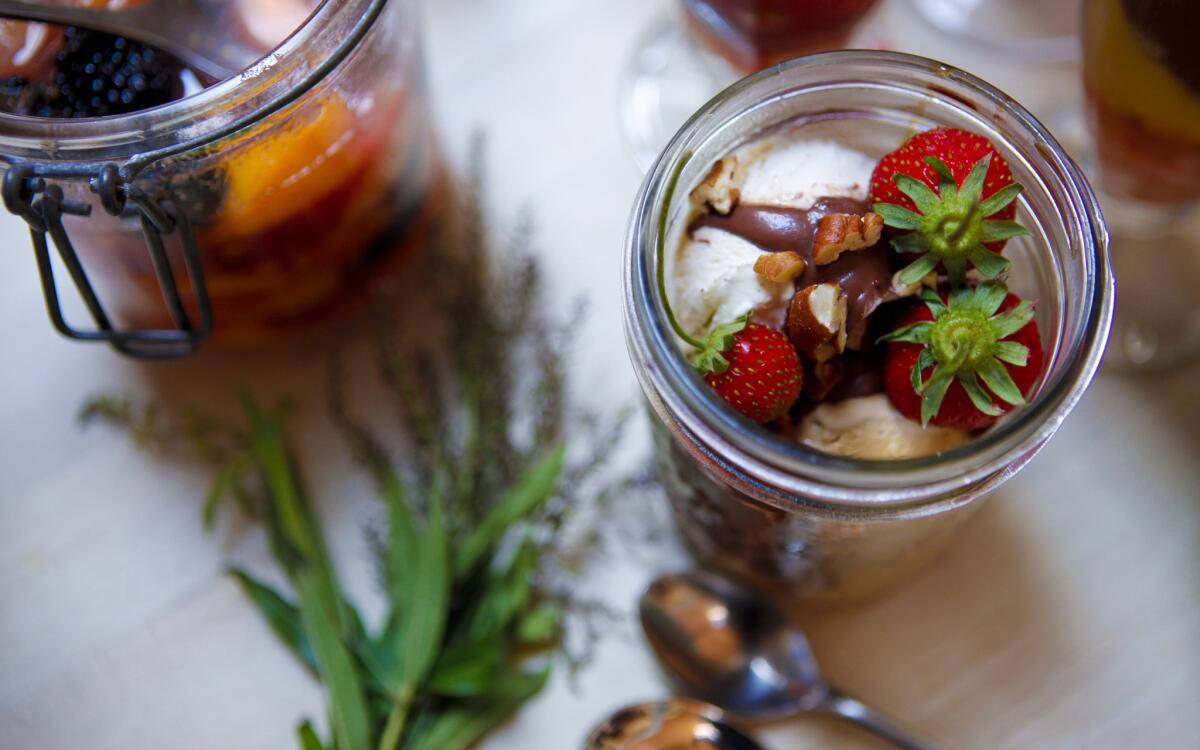Carob molasses ice cream

Amelia Saltsman spends a lot more time at farmers markets than you do. Unless youâre a farmer, at any rate, in which case you probably know Saltsman and have maybe talked to her for her first book, âThe Santa Monica Farmers Market Cookbook,â which you can still find at Anthropologie stores. Saltsman has been cooking and writing about cooking for decades and has finally published her long-awaited second cookbook, âThe Seasonal Jewish Kitchen.â Think more farmers markets, but this time Saltsman is channeling her childhood (her family is Romanian-Iraqi-Israeli), and in her new book she cooks her way through the Jewish calendar. To quote Deborah Madison, another market junkie who wrote the bookâs foreword: âThis is Jewish food? Who knew?â
Recently we met up with Saltsman at her Santa Monica home to chat and to make ice cream sundaes for lunch. Because wouldnât you? Also because these Brooklyn Bar Ice Cream sundaes are just the thing for summertime in L.A., as much as they were for Saltsman herself when she first ate them as a little kid at the popular cafe in Tel Aviv. Check out the recipes, then go to the farmers market (of course) and make ice creams and sorbets with local fruit. Make sauces. Layer sundaes like building blocks. Eat them for lunch too.
Your parents met in the Israeli army?
My father was a captain and my mother was sergeant. My father would come into the office that my mother was working in â even though women were weapons-trained, they worked in offices back then.
Why write about Jewish food?
I wanted to use [the book] to give traditional context to our modern seasonal lives â and I wanted to make it feel universal. This was the next step on the journey â more personal, more biblical. Weâve been talking about knowing where our food comes from; Iâve been looking at that through time. With this particular lens, I was also looking at the journey of ingredients. Like the citron. How did it travel? Who was carrying it? The citron wasnât a fruit in the Bible. Itâs a scrubby old thing, not a sturdy tree. But it was considered a perfect fruit â because of the aroma. Then it became a symbol carried by the Hebrews as they migrated. Think of it as an agricultural diaspora as well as the diaspora of the Jews.
So many dishes (yours, everyoneâs) are about building blocks. How do you decide how to put them together?
I think of it in terms of flavor and texture and color contrasts. And what the foods bring to each other â I like to flavor food with other foods. There arenât a lot of bottles here on the counter. This is what the farmers give their lives to. You want to respect the ingredients and not mask them â and thatâs a real shift in how we cook. The essence of seasonal market-based cooking is not to mess with what the farmers have already done.
Three tips for shopping at farmers markets?
One, shop (and eat) in âlayersâ to get the longest-lasting reward. Buy a mix of shelf-stable, medium-hold and perishable items, and use the most perishable items first. With items like tomatoes or stone fruit, buy a range of moderately ripe to dead-ripe, so you can pace your enjoyment throughout the week. Two, focus on whatever is at the peak of its season. Try to resist the urge to splurge on first-of-the-season appearances; a little patience rewards us with the greatest flavor. Three, engage all your senses, including common sense. Trust your inner smarts and youâll be fine. Itâs just food. But oh, what food.
How much has changed in the food scene since you started writing about it?
It depends on what weâre talking about. If weâre talking about Los Angeles, if you go back to the Los Angeles Times archives from the 19th century, youâll find discussions about farmers markets and whoâs selling and whoâs honest and the people peddling the best fruit. L.A. County was the biggest growing county in the state for a long time â famous for its Cahuenga apricots and all these little microclimates. We just had to come back to it. Itâs a cycle. âThereâs nothing new under the sun.â (Thatâs Ecclesiastes.)
Set a mesh sieve over a 2-quart bowl. Rest the bowl in a larger bowl filled with a good handful of ice and a little water, and place near the stove. In a medium bowl, lightly whisk together the yolks.
In a medium saucepan, combine cream, milk, sugar and salt over medium heat and bring to a boil. Turn off the heat. Take 1 cup of the hot cream mixture and stream it slowly into the yolks, whisking constantly. Slowly whisk the egg-cream mixture back into the saucepan. Reduce the heat to low and cook, stirring frequently with a wooden spoon, until the mixture is thick enough to coat the back of the spoon and stays parted like the Red Sea when you run your finger across the spoon, 2 to 4 minutes. Be careful not to overcook, as the mixture will curdle. Pour through the prepared sieve to remove any bits of cooked egg.
Stir the custard a few times to cool it down a bit and then stir in the carob molasses. Strain through the sieve again. When cool, cover with plastic wrap, pressing it directly onto the surface of the custard, and refrigerate for several hours or up to overnight.
Freeze in an ice cream maker following manufacturerâs instructions. Transfer to a chilled container, cover tightly and freeze, preferably for several hours, before serving. This ice cream is creamy enough that you should have no trouble scooping it straight from the freezer.
Get our Cooking newsletter.
Your roundup of inspiring recipes and kitchen tricks.
You may occasionally receive promotional content from the Los Angeles Times.
















